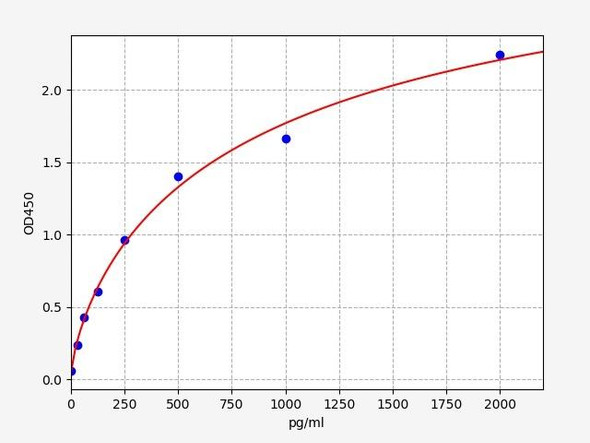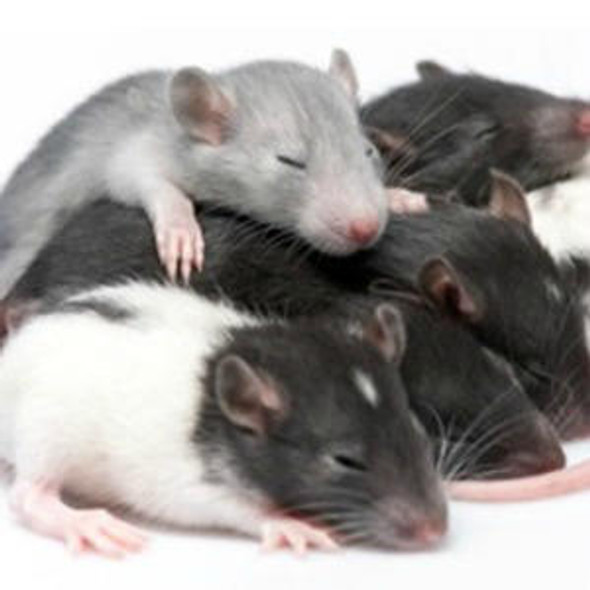Description
| Product Name: | PROK1 Rabbit mAb |
| Product Code: | CAB19268 |
| Size: | 20uL, 50uL, 100uL |
| Applications: | WB, IF |
| Reactivity: | Human, Mouse, Rat |
| Host Species: | Rabbit |
| Immunogen: | Recombinant protein of human PROK1 . |
| Applications: | WB, IF |
| Recommended Dilutions: | WB 1:500 - 1:2000 IF 1:50 - 1:200 |
| Reactivity: | Human, Mouse, Rat |
| Positive Samples: | 293T, HepG2, Mouse liver, Mouse kidney, Rat ovary, Rat kidney |
| Immunogen: | Recombinant protein of human PROK1 . |
| Purification Method: | Affinity purification |
| Storage: | Store at -20°C. Avoid freeze / thaw cycles. Buffer: PBS with 0.02% sodium azide, 50% glycerol, pH7.3. |
| Isotype: | IgG |
| Sequence: | Email for sequence |
| Gene ID: | 84432 |
| Uniprot: | P58294 |
| Calculated MW: | 14kDa |
| Observed MW: | 14KDa |
| UniProt Protein Function: | PROK1: Potently contracts gastrointestinal (GI) smooth muscle. Induces proliferation, migration and fenestration (the formation of membrane discontinuities) in capillary endothelial cells derived from endocrine glands. Has little or no effect on a variety of other endothelial and non-endothelial cell types. Induces proliferation and differentiation, but not migration, of enteric neural crest cells. Directly influences neuroblastoma progression by promoting the proliferation and migration of neuroblastoma cells. Positively regulates PTGS2 expression and prostaglandin synthesis. May play a role in placentation. May play a role in normal and pathological testis angiogenesis. Belongs to the AVIT (prokineticin) family. |
| UniProt Protein Details: | Protein type:Secreted; Secreted, signal peptide; Cell cycle regulation Chromosomal Location of Human Ortholog: 1p21 Cellular Component: extracellular region Molecular Function:growth factor activity Biological Process: activation of MAPK activity; positive regulation of cell division; positive regulation of cell proliferation; angiogenesis; regulation of angiogenesis |
| NCBI Summary: | The protein encoded by this gene induces proliferation, migration, and fenestration (the formation of membrane discontinuities) in capillary endothelial cells derived from endocrine glands. It has little or no effect on a variety of other endothelial and non-endothelial cell types. Its expression is restricted to the steroidogenic glands (ovary, testis, adrenal, and placenta), is induced by hypoxia, and often complementary to the expression of vascular endothelial growth factor (VEGF), suggesting that these molecules function in a coordinated manner. [provided by RefSeq, Sep 2011] |
| UniProt Code: | P58294 |
| NCBI GenInfo Identifier: | 17380189 |
| NCBI Gene ID: | 84432 |
| NCBI Accession: | P58294.1 |
| UniProt Secondary Accession: | P58294,Q5VWD4, Q8TC69, |
| UniProt Related Accession: | P58294 |
| Molecular Weight: | 11,715 Da |
| NCBI Full Name: | Prokineticin-1 |
| NCBI Synonym Full Names: | prokineticin 1 |
| NCBI Official Symbol: | PROK1 |
| NCBI Official Synonym Symbols: | PK1; PRK1; EGVEGF |
| NCBI Protein Information: | prokineticin-1; EG-VEGF; mambakine; black mamba toxin-related protein; endocrine-gland-derived vascular endothelial growth factor |
| UniProt Protein Name: | Prokineticin-1 |
| UniProt Synonym Protein Names: | Endocrine-gland-derived vascular endothelial growth factor; EG-VEGF; Mambakine |
| Protein Family: | Prokineticin |
| UniProt Gene Name: | PROK1 |
| UniProt Entry Name: | PROK1_HUMAN |






